|
FAQs on Marine Algae and Their Control 20
Related Articles:
Avoiding Algae Problems in Marine System,
Algae Control,
Marine Maintenance,
Marine Scavengers,
Snails,
Hermit Crabs,
Mithrax/Emerald Green Crabs,
Sea Urchins, Blennies, Algae
Filters, Ctenochaetus/Bristle Mouth
Tangs, Zebrasoma/Sailfin Tangs,
Skimmers, Skimmer Selection, Marine Algae, Coralline Algae, Green Algae, Brown
Algae, Blue-Green
"Algae"/(Cyanobacteria), Diatoms, Brown
Algae,
Related FAQs: Marine
Algae Control FAQs 1, Marine Algae
Control 2, Marine Algae Control
3, Marine Algae Control 4,
Marine Algae Control 5, Marine Algae Control 6, Marine Algae Control 7, Marine Algae Control 8, Marine Algae Control 9, Marine Algae Control 10, Marine Algae Control 11, Marine Algae Control 12, Marine Algae Control 13, Marine Algae Control 14, Marine Algae Control 15, SW Algae Control 16, SW Algae Control 17,
SW Algae Control 18,
SW Algae
Control 19, SW Algae Control 21,
& Marine Algicide Use, Nutrient Limitation, Marine Algae Eaters, Culturing Macro-Algae; Controlling: BGA/Cyano, Red/Encrusting Algae, Green Algae, Brown/Diatom Algae, Phosphate
|
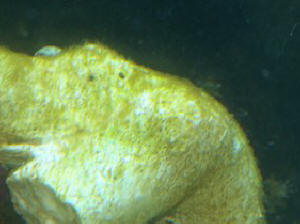
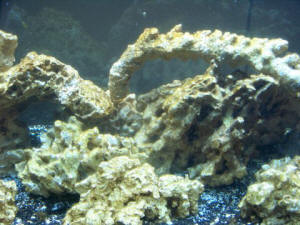 |
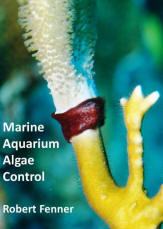 |
New Print and
eBook on Amazon
Marine Aquarium Algae Control
by Robert (Bob) Fenner
|
"Magic Blue" by Biotec
5/8/13
Hi Crew,
On a completely different note, have you ever heard or experienced a
product called "Magic Blue" by Biotec?
<Am familiar w/ other dyes like this. Our old company's AquaTech
division made such agents for pond, lake and fountains>
It is an "inert" Blue water colourant (not MethB)
intended to inhibit Algae growth. I have tried it
previously with some success and no observable effects on fish and
corals...
<... I wouldn't put these dyes (though chemically inert; their mode of
action is light-diffraction) in aquariums>
that I could spot, but always felt uneasy using it.
I'm considering trying it again in my ongoing battle with hair algae
<... Look to nutrient limiting methods, exclusion... predators,
competitors... These, this is all gone over and over on WWM, though I am
writing an e-book on marine algae, control presently... As I see the
need/market>
which I am currently losing (all usual causes attacked such as
phosphates, nutrients, salinity) possibly due to the spectra of some new
Marine-Glo T5's. I'm a bit reluctant to use it again as I have found
literally no-one else on the interweb with a comment on it!
I also have Marine Algae-fix
<...>
which does work a treat, but in my experience causes a competitive
imbalance between the various Algae species after treatment (i.e. it
will kill whatever dominant Algae is present, say Bryopsis , but open
the way for takeover by BGA , or diatoms etc. soon after treatment ,
which will proliferate readily in the absence of the former competitor).
<... yes>
Any thoughts?
<The reading, consideration of adding sump/refugium, RDP, DSB... BobF>
cheers,
Rama
|
RE: Help Needed!!
Filamentous algae in a comm. setting 5/4/13
Hello Crew , hello NateG !!
<Kostas>
Here is a quiz on which I have spent too much time on.
As Mr. Bob already knows , I am a pet shop owner specialized on aquariums.
In my corals tank I have the following problem the last 6 months.
The tank "produces" 2 types of algae (as I believe) as per photos. First
time I noticed that was after I received for a customer a Caulerpa rock that
I hosted for about 14 days. In this tang as a cleaning crew I have a Lo
Vulpinus , a Ctenochaetus Tominiensis , Salarias Fasciatus , Six Line wrasse
and a Mandarin. Tomini usually was hitting the Caulerpa rock so at first I
was thinking that Tomini moved the Caulerpa at other places in the tank and
Caulerpa started growing , so after 2 months I removed the whole algae (or
as much as I could from the racks) manually. Removed all the corals and
cleaned theirs rock and then removed the sand bed , and cleaned all the
glasses and racks. After the cleaning procedure , changed the 40% of water ,
picked another sand bed (black one) but the quantity was less than what I
removed. After 2 approx months the same thing happened , cleaning once again
the whole tank manually. Right now , once again after 2 months we are at the
same point.
So here is the set up and parameters of the tank
700 Litres (350 x 40 x50 cm )
No sump.
<I'd add/ w a DSB, a RDP lighting arrangement>
An external filter (Rena XP3) 1250 ltr/h , with Sera's activated carbon ,
Sera's Phosvec Granulat and Sera's Silicate clear.
Aqua medic Skimmer shorty 3500 with 2 x Eheim 1260
3 x Tunze Turbelles , 4000 ltr/h each and Tunze wave box.
All the parameters are measured by Hanna's equipment.
Salinity 1026
Temp: 25 Celsius
PH: 8,1 - 8,3
KH : 8,5 - 9
Ca: 420-445 ppm
Mg: 1260-1300 ppm
NH4 undetectable
NO2 undetectable
NO3 <1,3
PO4 < 0,10
I dose manually every day Ca and KH , and magnesium as needed.
I use Seachem-AquaVitro Fuel twice a week ( I know that this could be fuel
for algae also)
<Yes>
I feed every 2 days Gamma NutraPlus complete feed (as per tank litres)
I feed every day Sera's GVG mix , and Gamma frozen Brine shrimp.
I use AquaVitro salinity salt.
If you need any other info please let me know
I would appreciate your thoughts.
Best regards
Kostas
<I'd likely add a phosphate limiting chemical (Lanthanum) or absorbent here
to knock the PO4 down an order of magnitude... The DSB arrangement will do
this long term. Bob Fenner>
|
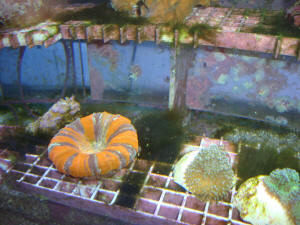
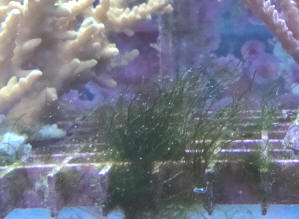 |
|
Re: Help Needed!! Comm. alg. control... new eBook
announcement 5/8/13
Thank you very much for your reply and your thoughts.
Unfortunately is not possible to install a sump at this tank. (no space
at all)
<Maybe large canister filters then?>
Any idea what kind of algae are those?? I tried to match them with some
other photos from WWM but with no success.
<Have to look through a microscope... could be some sort/species of
filamentous green (Chlorophyte) or even a BGA (Cyanophyte), or...?
Algae/Thallophytes and the Monerans that are Blue-Greens are classed at
the Division level on the bases of their gross micro-morphology, storage
foods, photosynthetic pigments... see the Net or works on
Phycology/Algology re.
Am writing an e-book re presently>
Best regards
Kostas
<And you, Bob Fenner>
|
Algae from sunlight, FW, SW, doesn't matter... 4/1/13
First off, I really appreciate your time! I have a 55 gallon tank that I
have maintained for years. I have recently moved and my new house has
windows galore, and the house is in an open area, so there are no trees
and the sun shines all day. I placed my tank in the best place that I
could, but of course now I have pea soup. Everything reads normal, like
in years and years past, like when my water was crystal clear. I would
hate to give up my hobby because I bought a house with too many windows.
I haven't been able to find anyone on the Internet with my problem (
heard of it short term, but not the long term like I seek) I talked to a
guy at a local fish store, and he told me that I should get a uv
filter, and run it while the sun is out, and turn it off at night.
Opinions?
<The UV can/will help to zap/kill free floating/living algae et al., as
well as help more indirectly to raise RedOx, dissolved oxygen, oxidize
algal-feeding nutrients... Other ways exist to aid your algal control
efforts. These are archived on WWM>
Thanks for any assistance!
Thanks,
George
<Welcome. Bob Fenner>
Re: Ammonia help; alg. contr.
3/20/13
Does heavy algae mean anything? I cleaned just the front of the tank and
in a few hours it is covered with algae again!
<Indicates there's plenty of all necessary nutrients, and a lack of
competition. BobF>
Re: Ammonia help 3/21/13
What do you mean by lack of competition?
<Ahh, read here:
http://www.wetwebmedia.com/nutrientcontrol.htm
and the linked files above. B>
Green water 3/13/13
Hi gang, love the site. Keep up the great work. I'm trying to figure out
the culprit for my recent bout with greenish/yellow water. Common
sense/experience tells me its an algae bloom, however the usual routine
I would expect to correct the problem hasn't seemed to work. The
system is several years
<Your LR may well need "renewing"... see WWM re>
old and is 150 gallons, FOWLR, with a wet/dry
<A principal source of trouble; particularly any/all mechanical media
here. Again, search, read on WWM re... esp. the poss. of
converting this dinosaur to a refugium>
and protein skimmer. Admittedly my protein skimmer isn't the best and I'll
likely be replacing it in the near future. Having said that, it's been
in the system for several years now with never having had this problem
before.
<Mmm, well; systems do "age" as you'll soon find out>
Water quality remains constant and within the appropriate ranges, I'm
feeding the little critters the same way I always have and no new
inhabitants have been added. Filter media is cleaned and changed
regularly as well. I am not having issues with excess algae growth on
rocks...no hair or slime algae to report. Just the usual coverage on
rocks you'd expect to see. Any thoughts on what I am missing here?
<Oh yes. Read on! Bob Fenner>
black hair algae... SW, little data, no rdg.
2/14/13
Hi Guys,
Long story short; thick black hair and brown algae,
<Mmm, color/s are not definitive in determining which group/Division of
algae one is observing>
parameters ok, 25% H2O changes. I know this probably started from
overfeeding, but I can't get rid of it. Tried a product that my
LFS owner makes; (so he says); he is a Marine Biologist. (called
SAT).
<Don't know of this... Scholastic Aptitude Test material; but am NOT a
fan of algicides... too toxic, too ineffective. One needs to deal w/
causes/allowances... lack of competition, predation, addition or lack of
control of nutrients... Many roads... all gone over and over on WWM. Am
soon to refer you>
It is given in three doses every two weeks. Things were looking
much better, no problems with my crew. On the third dose, my
favorite fish, a dragonet was upside down the next day, with no signs of
life. Cried, took him out, limp in my hand and he suddenly jumped
on the floor. Put him in the hospital; great recovery. Back
in 125 tank, doing better than ever.
I also have an anemone that is 12 inches when fully opened.
Question...I got Seachem's SeaGel, as I have well water testing very
slight phosphate. Also got nitrifying bacteria, Stress Coat, and
am going to do a 30% H2O change. I've tried snails, crabs with no
luck.
However, my chocolate starfish is fat and taking care of some of it.
I do not want to use any chemical additive because of my last result.
Any suggestions greatly appreciated.
Cheers!
Jo Anne
<.... read here:
http://www.wetwebmedia.com/avoidingalgaeproblesm.htm
and the linked files above and embedded in the text. Bob Fenner>
Phosphates... really/and algae control; RO maint. 02/13/13
Hi crew,
<Jay>
I am having an issue that I can't pinpoint and I was hoping maybe a third-party
perspective could help find the source of my problem. I am having issues with
brown hair algae in my 75gallon (year and half old) reef. I know that in
order for algae to thrive it requires the presence of nutrients in the water.
<Among other pre-disposing factors... such as a lack of competition, predation,
low circulation, low RedOx, DO...>
All my parameters are in check except for phosphates. I am using a Red Sea
test kit and the water from my tank is showing .8ppm of phosphate.
I figured now that I know what my issue is I need to work on my nutrient export.
For the last 3 months I have been doing 10 gallon water changes every week
religiously.
<An expensive and slow means... dilution>
Every month I am removing 40 gallons of water which is about half the water
volume (I also have a small sump). I have been removing filter socks regularly,
blasting the rocks during water changes to syphon out detritus and physically
removing the algae from the rocks.
<And, as the saying goes: "How's that working out for you?">
I started to see a bloom of coral line algae begin to grow on the rocks and the
algae starting to die off. Great! I kept up my water changes.
After a water change three weeks ago. I got a huge bloom of algae again.
I was so disappointed. I looked at my RO/DI unit and figured maybe I would need
to change the media out even though my TDS meter shows no traces. I ordered up
the media and skipped my water change last week.
The algae began to die again. MY media came in and I was making water yesterday
for a water change. I got curious and tested the water coming out of my RO/DI
for phosphates and low and behold it was reading .8ppm.
How could this be?
<Mmm, faulty membrane/s, bad carbon in the contactor...>
What else can I possibly do to treat my water?
<Quite a few things actually, but I wouldn't go this route... I'd focus on other
means...>
I use an Aqua FX Barracuda RO/DI. The membrane is not even a year old and the
other media is brand new as of yesterday. I made around 20 gallons of water
yesterday and I could see the DI cartridge was already that rusty color at the
top of the cartridge from just making 20 gallons. I have a TDS meter installed
on the unit and can see that the meter is picking up traces coming into the unit
and then as it exports it I get the 0 reading.
I am basically introducing the phosphates into my tank in the form of water
changes and cap-offs.
<And foods>
I have no fish in the tank at the moment.
<Oh, not much food then>
I only have inverts in the forms of a few corals, shrimp and a reef
lobster. What do you suggest?
<That you read here:
http://www.wetwebmedia.com/avoidingalgaeproblesm.htm
and as much of the linked embedded and sorted files at the top that you consider
prudent... and consider a long-term approach, solution... Adding a DSB in a
sump, live macro-algae in there/a tied in refugium, on a RDP timed lighting
scheme. Bob Fenner>
|
Red Turf War Continues!/Algae Control 2/12/13
<Hi Pam>
It's been a year since I set up my 75 gallon reef tank.
I have not been able to defeat the red turf algae growth!
It all but smothered my rock when I decided to purchase 18 Mexican turbo
snails.
They cleaned about 30% of the algae.
Here are specs;
• 100 lbs LR
• 4inch DSB
• HOB Remora Skimmer
• HOB fuge
• HOB filter w/ Boyd's Chemi Pure Elite and Poly filter
• Ro/Di water only !
• 2 strong powerheads providing excellent flow.
• T5HO 3-10k/3-460nm Actinics lights (on12 hours total)
• Oceanic Sea salt
• kH 8
• pH 8.3
• Cal 440
• SG 1.024
• Mag 1440
• Temp 76 degrees
I change 10g every week ALWAYS with RO/DI
<RO/DI water does not guarantee an algae free tank.>
Top off every 2 days with ro/di
Livestock is one 4" LOPEZI Tang
3 blue damsels
1 Brittle Star
Many snails, crabs, and the 18 Turbos.
I have ordered 10 more Zebra Striped Turbos.
Do you think the snails will ever catch up to this nuisance algae?
<Don't know. You have to fix the nutrient source.>
Is there something I've overlooked?
<Yes. Where are your nitrate and phosphate test results?>
In the 2 attachments you will see a side by side comparison, and then the
present day overall shot of the tank.
thank you for any advice and hope for the future of this tank!
<I suggest you read here and related articles found in the header.
http://www.wetwebmedia.com/algaeconMar.htm
James (Salty Dog)>
Pam
|
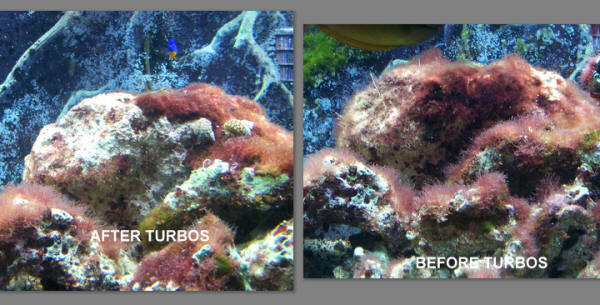
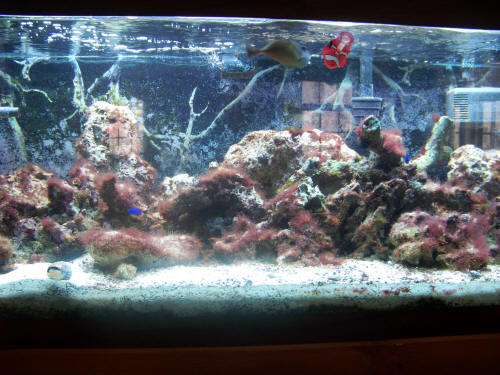 BGA
BGA |
Red algea – 12/03/12
Hello guys, to continue from my last question
<?>
about the red algea,
<A Cyanophyte? Rhodophyte?>
would a Reverse Osmosis filter help keep this from growing? Thanks again,
chris.
<? Likely so; depends on the cause, conditions allowing... See WWM re
control of whatever group this is. Bob Fenner>
Hair Algae Solutions 11/24/12
Dear Crew,
<Big B!>
Cheers, its been a while. I recently let the time between water changes
get a bit out of control, and now am dealing with the consequences. My
tank is covered in Hair Algae. It is so bad I am worried it will smother
my corals.
One solution: I have a second tank running under the exact type of
lighting, even the bulbs are the same age. I could put the corals in
that tank and starve the algae of light. I would then probably do a
massive water change, or two. The second option: Just pick it all off
the rocks and do frequent water changes. I am personally partial to the
first, but I would like your opinion. My corals include: Encrusted
Orange Sun, Trachyphyllia geoffroyi, Caulastrea furcata, Goniopora spp,
Duncanopsammia
axifuga, Montipora digitata, Blastomussa sp, Favites sp, Platygyra sp.
Bryce
<Mmm, well, worthy approaches... I'd have you add, compare using
predators, nutrient limitation, competition... Read here:
http://www.wetwebmedia.com/FilamGrnAlgC4.htm
and the linked files above... till you feel you have the gist of
your possibilities. Bob Fenner>
Moving out of algae farm: re-send; SW algae control
11/12/12
Sorry if I'm jumping the gun by re-sending this. I realize Bob has been
away, but it has been a week since my original submission:
<Hadn't seen; may have been picked out by the auto-spam program...>
Howzit, folks?
<Finer today>
My 38-gallon SW tank looked great for the first couple of years, and then went
quickly downhill.
<Not atypical... easily soluble materials lost in substrates (rock,
sand/gravel)... lead to such issues in smaller volumes w/in this time frame
commonly... loss of ready available alkaline earths, alkalinity... Hence the
usual call for replacement, addn....>
I have been battling various phases of nuisance algae for a couple of
years now, with no success. I started using RO water, added an Aqua-C
skimmer and a HOB refugium full of LR rubble and Chaeto, and thickened the sand
bed to over 3". Circulation is probably 25x/hr or more, and I’ve played
with the amount and configuration of the LR to eliminate dead spots. I did
try vodka dosing with some success, but in the long run the algae has won out;
it continues to grow on LR, substrate, glass, equipment, even my Hermit Crabs'
shells. In previous correspondence with Bob, he concluded that I must have
a problem with phosphates leaching from somewhere.
<May be>
At that point my livestock was down to a pair of Ocellaris, and a few snails and
hermits. I took a sample of
my substrate and let it soak in a container of saltwater for several days,
but it did not test positive for phosphates. I then slowly took out my LR
until I only had one rock left, which had a large leather coral attached.
The algae persisted. Finally, I hammered a good-sized chunk off the rock with
the coral on it, and let that sit for a few days (consequently, the coral has
shrunk up and has receded to about half its size, but still extends its polyps -
not sure how to approach rehabbing it). The rock fragment also tested
negative for phosphate. So, I am stumped. Large (33%) water changes
seem to arrest the algae for a little while, but smaller ones do not. That
could get expensive. The only idea I have left is going back to the
substrate. It is the Seachem Gray Coast calcite, which they say has a
grain size of 1.5-5mm. Maybe this is too large for a DSB,
<Smaller would be better... 1-1.5 mm>
it is holding nutrients, and my test was off?
<Again, perhaps>
Anyway, I’ve spend too much time and money on this to quit, I’m stubborn
like that, so here is what I want to do: I got a ridiculous deal on a 50-gal
tank with 216W T5 lighting. I want to move the 38-gal into that. How
can I do this while minimizing the chances of importing all my nuisance algaes?
<Start w/ new... oh I see this below>
Should I completely start over with the LR and sand bed?
<The sand bed; but I'd likely keep the LR>
With the bigger footprint, I’m going to need more sand anyway; should I
just try putting a couple of inches of sugar-fine sand underneath what I already
have, and maybe mix some smaller sand into the upper layers as well?
<I'd place side to side to start, mix over the next few weeks>
Should I cram a HOB filter on the back wall with the refugium and skimmer,
with ceramic or other media, or replace the LR rubble in the refugium with
ceramic instead? Please help me figure out how to make this work.
Mahalo,
Scott
<Well, more filtration, flexibility is always nice... the 'fuge has a RDP light
program? Macro-algal culture? Just for review, let's have you read through here:
http://wetwebmedia.com/avoidingalgaeproblesm.htm
and the linked files embedded and above where you deem of use. Bob Fenner>
Re: Moving out of algae farm: re-send
11/13/12
Thank you for your reply, Bob. I think I am going to go ahead and
replace the whole sand bed.
<Likely a wise decision>
As I understand it, the calcite has basically no buffering capacity
anyway.
<Correct; am not a fan>
I'll try a couple of inches of oolite on the bottom with a couple more
inches of the .5-1.5mm on top.
<Will be/get mixed in time; no biggee>
I do have Chaeto in the refuge and it is set on a reverse-daylight
cycle, with some overlap.
<Good>
I was thinking that while I am changing things over, I might also try some
Fiji Mud in there as well. As to the leather coral, do you have
any suggestions for rehabbing it?
<The usual cutting/s, tying down or spiking (vs. adhesives). See here
re: http://www.wetwebmedia.com/alcyonpropfaqs.htm
If it would help, I could set it up by itself in a 20H with 28W t5 NO
lighting. Is there something I should be feeding it?
<Mmm, yes. See the linked file above where you've just been referred:
"FAQs on: Alcyoniid Feeding"... do need soluble phosphate and nitrate>
This thing had more than doubled in size in the few years I have had it,
it was very large and bushy without any specific feeding. It is
still putting out polyps and shows no signs of necrosis, it is just
wilting and receding.
<Natural behavior in most cases... DO get very large in time... and can
mal-affect other livestock>
Thanks again,
Scott
<Welcome. Bob Fenner>
Calcium Carbonator / Algae Growth 10/17/12
Hi. Any opinions on Calcium Carbonator by Reef Results Marine
(http://www.calciumcarbonator.com )?
<Mmm... don't like mis-use of the term "natural" in their ads, nor the lack of
detail concerning the ingredients, and not a fan of one part solutions for
providing alkaline earth (this one only Ca) and alkalinity to captive systems.
Not sufficient control. Am a much bigger fan of proven two (or more) part
solutions for providing same, calcium reactors (w/ appropriate media)...>
The guy at the LFS pushed it when I was there about 3 weeks ago to pick up
some calcium. Since then I've had MAJOR algal blooms that I can't seem to
get on top of.
<Uhh, I'd switch back to previous SOP>
I haven't found much credible discussion about the product online, so I'm
not sure if its the culprit or just coincidence.
<Me neither, given the stated data, but... would still revert. Bob Fenner>
|
Septicemia on my yellow tangs
7/24/12
Sorry for bothering you, since I know you are so busy maintaining such
an excellent database of marine aquarium knowledge, but I seem to be
having quite a problem with my saltwater tank. A while back I asked a
question regarding my ocellaris clownfish and my Koran angelfish.
Unfortunately, while I had them in quarantine, we lost power for a few
days. The only survivors were the ocellaris clownfish pair. Since then,
my tank has been doing quite well, and I've added some fish (after a
lengthy 6 week quarantine, in which everything received 2 doses of
Prazi-pro at full strength as well as Cupramine at half strength). The
problem is that just recently (after being in the display over 2 months)
both
<Two; my emphasis here>
of my yellow tangs began to show red blotches on their bodies (one much
worse than the other). At first it was only in the dorsal fins, but now
it has spread to the caudal peduncle of the slightly smaller specimen
(who is boss over all the tangs in the tank). My
tank is a 187 gallon (60"x24"x30") which I hope to be converting into a
reef. Here are my levels:
pH: 8.3
Salinity: 1.025
Ammonia: undetectable
Nitrite: Undetectable
Nitrate: between 0 and 5 (working on lowering this)
Phosphate: 0.005 (working on lowering this as well)
<Not to worry; this is low enough>
I run a G200 protein skimmer (which I skim more on the wet side), as
well as having a 55 gallon refugium, and performing weekly 20% water
changes.
Current fish include:
2 Yellow Tangs (which have gotten along great since I got them,
even sleeping in the same cave at night)
<As far as you've seen>
1 Sailfin Tang (who schools with the yellows during the day)
1 Bariene Tang (who is the smallest tang currently, but growing fast)
1 High Hat Drum (love this fish; he's hardy, is growing fast, eats
everything, and cleans the sandbed)
1 Papuan Toby (who hasn't nipped any fins yet, got him for free from a
friend)
1 Melanurus Wrasse (A fully grown male, quite spectacular)
1 Bluehead Wrasse (awesome fish, but destroyed the hermit crabs)
1 Arc Eye Hawkfish (same as above)
1 Sleeper Banded Goby (Amblygobius phalaena) (he keeps my sand perfect
and made a burrow right up front in the tank)
2 Ocellaris clowns (a breeding pair)
1 Blue devil damsel (who is the smallest fish in the tank)
2 Yellow tailed blue damsels (who paired off pretty early on)
The fish are fed 2 times a day (Mysid shrimp, and marine cuisine in the
morning; Nori and Prime reef at night). All fish (including the two
yellow tangs) act normal and eat greedily (all of them have the fish
equivalent of a beer gut). I just can't figure out why the red won't go
away on the yellow tangs.
<"Something/s stressful"... not likely water quality given the readings
you present, the gear you have, the other livestock kept... more likely
"something" in the cave they share (e.g. Bristleworm) or themselves
interacting... I'd separate the two, only keep one in this system>
Occasionally it seems to be getting better, only to look worse the next
time I look at them. I am currently performing a 20% water change, and I
will be grabbing some Maracyn 2 in the morning (in case the tangs get
worse and I need to move them to quarantine to treat them). Do you have
any other suggestions for me? Are there any medicines that would work
better than Maracyn 2?
<No medicine/s called for, advised>
Thanks in advance and keep up the good work,
Ashton
<For review, please peruse the Z. flavescens hlth/dis. FAQs:
http://www.wetwebmedia.com/ytangdisf6.htm
and the linked files above. Bob Fenner>
Re: Septicemia on my yellow tangs 7/24/12
Dear Bob,
Thank you for answering my question, but I'm still stumped. The 2 yellow
tangs show no aggression at all between them, and had lived together in
a 75 gallon for about 3 years before I bought them. I actually teach
piano and the tank is next to the piano, so I am able to watch them for
most of the day and never see aggression.
<Might not be aggression per se, but just stressful to be in company...
in the wild this species lives individually or in dozens to a hundred or
so individuals in a moving shoal>
If I do notice aggression I can move all the cichlids out of their 180
gallon tank and turn it into a tang/trigger/puffer/grouper FOWLR. As for
the 2 yellow tangs being bothered by a Bristleworm, I do not think that
is the case. Right before I added the two yellow tangs to the display I
came downstairs at 1:00 in the morning to discover my seagrass filefish
(Acreichthys tomentosus) being devoured by a 2 foot worm.
<Yeeikes!>
I ended up dismantling the entire display and found the worm hiding in
my sandbed. Upon searching Google I found out exactly what it was: a
bobbit worm. I was paranoid about having any others like it in my system
and I treated the display with Cupramine. Could the septicemia be the
result of copper leaching from my live rock?
<Yes; could be a factor>
I know tangs do not like long term exposure to copper. If there is
residual copper should I just continue to run the skimmer, bump water
changes to twice weekly, and add a Polyfilter pad (the ones designed to
absorb copper and other chemicals)?
<Yes>
I could also run some activated carbon. I ended up buying some Triple
Sulfa at the LFS this morning, because they recommended it over the
Maracyn 2.
<Please don't apply this... Of no use, and may foul up the bio-make up
microbially and hence to all>
If the tangs get worse (they look somewhat better after last night's water
change), should I put them in quarantine (divided from each other since
the quarantine is a 30 gallon) and treat them?
<No to treatment>
By the way, I spent about 4 hours going through every FAQ page on WWM
about yellow tangs. It was quite the interesting read.
<Ah yes... one of the top dozen or so marine species in terms of
popularity>
On a somewhat unrelated note, hopefully in about a month I will be
moving this tank to a different part of the house and building it into
the wall.
In the process I will be upgrading to a 125 gallon refugium behind the
wall with much better access than the 55 gallon refugium under the tank.
<I'd bet you're looking forward to this change and that it will improve
all's experience.>
Thanks again,
Ashton
<Welcome, and thank you for this follow-up. Bob Fenner>
Re: Septicemia on my yellow tangs 7/28/12
Dear Bob,
I'm sorry to bug you, but things are getting worse for my tank.
<I see this in your tank... and more... in your pix. A very likely
source of the trouble; the "something toxic" in your system>
I just added 2 more powerheads to the tank for increased circulation
(which made all the fish much more active), as well as taking the lights
off all of my freshwater tanks and putting them over this tank (which
also made the fish more active and much brighter colored). All my water
readings are exactly the same as they were in the first email, but the
two yellow tangs still have septicemia (although they are slightly
better than before). I added Cuprisorb to the tank, and it has had
absolutely no color change, so I guess I have no copper left in the
system. I also added 25 Astraea snails and they seem to be thriving (as
long as they stay tight to the wall during the day, the puffer and the
wrasses like harassing them).
However last night my high hat drum died for no apparent reason,
although he seemed rather listless last night (just kind of floating
around instead of his normal behavior of swimming back and forth begging
for food when I'm by the tank). That was a real disappointment to me as
he was one of my favorite fish, and he was thriving and eating like a
champ mere hours beforehand. My Bariene tang also seems to be having a
problem.
<Yes>
When I first purchased him, I had him in quarantine and he came down
with Ich within 48 hours. I proceeded to treat him with Cupramine for
the remainder of his time in quarantine (6 weeks), and he quickly
recovered (no symptoms after the first week of treatment). However, he
did glance at the decorations in quarantine and he gave himself a small
circular wound (which I thought was just a bruise). Today, it seems that
it wasn't just a bruise.
It is a perfect circle on his body, about a half inch across. It is
lighter in color than the rest of his body, and has something white
hanging out of it. All of the other fish seem fine, but I really am sick
of having my fish die on me, and I've gone through over 90 dollars of
salt in the past 2 weeks...
I've taken the liberty of attaching some pictures.
Thanks again,
Ashton Nietzke
<The mauve red on your rock... looks to be BGA, Cyanobacteria... is
poisoning your fishes. Please read here re:
http://www.wetwebmedia.com/bluegralgae.htm
and the linked files above... You need to react, soon... and I might
even go ahead and use the antibiotic route of chemical control here
(it's that much of an emergency)... in the long/er haul, doing what you
can/will to promote other algal types...
Bob Fenner>
|
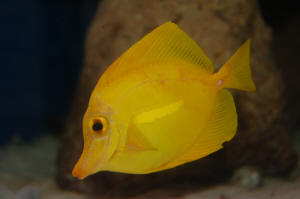
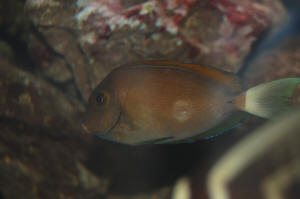
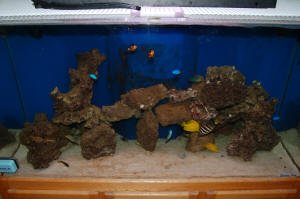
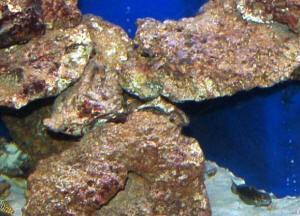 crop
crop |
|
Re: Septicemia on my yellow tangs 7/28/12
Dear Bob,
I guess I will go ahead and treat the tank with Chemiclean then
<Or any source of Erythromycin... WITH your close observations... ready to
change water and more... should the system disimprove quickly from the BGA
crashing>
(I just happen to have an almost brand new bottle a friend gave me when he
gave up on saltwater). Is there anything else I can do?
<... move out the LR, or move the fishes elsewhere>
When I treated the display with Cupramine, all of my Chaetomorpha in the
refugium died. I tried to go buy some mixed macro (Chaeto, Gracilaria and
Caulerpa) yesterday, but both of the nearby stores were out of all types of
macroalgae. I used to grow C. prolifera in the display but it was at the
point where my tank looked like a seagrass bed (which the filefish loved).
<MUCH better than the BGA>
I took it out because I read about all the instances of Caulerpa going
"sexual" and poisoning tanks online. The Astraea snails seem to like eating
it though, should I try adding some more snails?
<I wouldn't, no... you have too many already as far as I'm concerned. See
WWM re scavengers as such>
As for the Bariene tang, do you think it is just an injury healing itself
(he seems to be scraping it on the bottom and the rocks), or is it a
parasite or disease of some sort.
Thanks again,
Ashton Nietzke
<Welcome. Bob Fenner>
Re: Septicemia on my yellow tangs 7/30/12
Dear Bob,
I thought I'd give you an update, no matter how unpleasant it may be. The
erythromycin ended up making the algae grow much faster than before rather
than killing it.
<Mmm... nutrients released from the killed BGA>
It now covers the bottom of the tank and all the sides. I think it is
actually a Dinoflagellate and not Cyanobacteria.
<Do you have a microscope? Take a look at a sample... easily distinguished>
I ended up getting a ball of Caulerpa racemosa and Caulerpa taxifola, and
that is currently in my refugium.
<Okay>
When I went to the LFS to get the Caulerpa, I told them what was wrong
with the tank and they ended up selling me 2 sea urchins, a Halloween urchin
and a red spined blue tuxedo urchin (both of whom love Nori). They, along
with the 25 snails I already had, seem to be eating the Dinoflagellates, but
after reading about Dinoflagellates poisoning the animals that eat them, I
feel as if I should remove all the animals and put them in a different
system, and turning off all of the lights on the display for a few weeks. I
am pretty sure that I will divide the animals between my 30 gallon
quarantine (I feel as if the Zebrasoma will pick on the smaller bariene in
the 75 gallon) and my 75 gallon tank that currently has fancy goldfish in it
(I will move the goldfish to a kiddy-pool, change out all the freshwater for
saltwater, and add some bio-Spira for saltwater).
All of the invertebrates will go into the 75 gallon, since the larger water
volume should hopefully be more stable, and that tank hasn't been treated
with copper.
By the way, the bariene tang (which grazes this algae stuff more than the
others) looks the worst, and continues to get worse. The yellow tangs, both
of which eat it occasionally have septicemia still (and one is worse than
the other). The sailfin tang (which doesn't touch it at all), seems to be
having no problem, much like all of the other fish (which do not eat it
either). I plan on running over to the store in the morning and buying a 200
gallon box of instant ocean salt.
Is there anything else I can do?
<I'd add a great deal more small substrate to the refugium and/or
main/display tank, AND look into what your RedOx is... raise it w/ ozone
addition. This is, as the saying goes, WAR>
Thanks again for putting up with all my emails,
Ashton Nietzke
<Welcome. BobF>
|
Algae on the sand bed in a tank with puffer and trigger –
07/27/12
Hello!
<Tom>
First of all, thank you for your time in helping me out. I have
been searching for weeks trying to find an answer, and I am hoping you
can help me. I have a 210 gallon tank with the following fish:
1 yellow tang, 1 Kole tang, 1 blue spotted puffer, 1 humu humu trigger,
1 raccoon butterfly, and 1 Dragon Goby. All the fish get along
great, but my problem is the
sandbed is covered with algae.
<Mmm, the usual questions/concerns w/ available nutrients, lighting,
competitors, predators... various inputs for countering algal
proliferation... Read here:
http://www.wetwebmedia.com/algaeconMar.htm and the linked files
above>
I purchased the Dragon Goby hoping he could sift it away,
<Ah no... there are others:
http://www.wetwebmedia.com/marscavart.htm and the...>
but he's not even making a dent.
I have asked numerous LFS's and searched the web, but I cannot find a
solution. I'm told the puffer and trigger will wipe out anything I
can put in the tank to consume the algae.
I consider WWM to be the best place for information, so I'm hoping you
can give me some solution to get the algae eliminated and then kept out.
Thank you so much.
Thank you,
Tom
<Read on! Bob Fenner>
Two different pest algaes 7/18/12
Hello,
<Krista>
I've had a problem with Cyanobacteria for about a month. Recently I've
had another algae that is a golden brown to green and is hairy/fuzzy. It
isn't long but, it is choking out some corals.
<No fun>
The tank is a 40 gallon breeder that is 4 years old. I have three
power heads that are all pushing more than 500 lph. I have a
sump/refugium that is 30 gallons that I installed two weeks ago.
<This should help>
I have Chaeto and Caulerpa growing in it. Also, when I tested the water
this morning it seemed perfect. Only 10 nitrates, 0 nitrites, 0 ammonia
and an 8.2 ph. I only have a small clown fish, a Molly miller blenny, a
1 inch royal gramma and a yellow tail damsel.
I tried reducing feedings, sometimes for 3 days at a time. I've also
tried turning off the light for a week at a time. I recently added a few
extra Astraea snails and some blue hermits. It hasn't helped. Any ideas?
<Many. Read here:
http://www.wetwebmedia.com/marine/maintenance/maintindex.htm
scroll down to the tray: Algae Control
Bob Fenner>
algae and live rock quarantine 7/13/12
Hello there,
I have a 120 gallon tank with aragonite sand and about 100 pounds of
base rock...no life...set up about 3 weeks ago. I bought a nice 10 pound
piece of Pukani live rock
<Know the young gal it's named after>
and placed it in a 10 gallon quarantine tank with the intention of using
it to seed my future reef, after 4 weeks of observation. In the past,
when my base rock was live and in a prior tank (years ago), it was
infested with every type of Caulerpa and bubble algae known to man and
so my intention this time is to avoid these algaes in particular...hence
the quarantine. I know it’s impossible to avoid every pest every time,
but these I really don’t want in my tank because they can turn a
relaxing hobby into a frustrating laborious affair! Well, 3 weeks
into my quarantine, my rock has sprouted both Valonia and feather
Caulerpa...hahaha!
<Yikes!>
Just have to laugh! It also has some type of algae that looks like
individual flat top stools (the type you sit on) with tiny thorns, which
may be a form of Racemosa but it’s still too tiny for me to accurately
identify. So what to do? Is it basically futile to keep these things
out?
<Mmm, at this juncture, you could go the biocide route... I'd use
chlorine bleach if so. Read here re SOP:
http://www.wetwebmedia.com/clnornart.htm
and the linked FAQs file>
I mean, I will definitely pick and scrub this stuff off and leave in
quarantine an extra month but what if it sprouts again?
<"Only takes one spore">
Where does it end? Do I throw out a 90$ piece of rock with a ton of
life...worms, pods, feather dusters, brittle stars etc?
<I'd isolate the live part... see if you can find, scrub off (outside
the holding system) and rinse any pest part away>
The next piece will likely be the same! Should I clean it up and just
place in my tank and accept that I will likely have some algae issues I
will have to deal with? I thought this was suppose to be fun...a big
sarcastic “ha”!
<Is one approach...>
Thanks much,
Dave
<Welcome. Bob Fenner>
Re: algae and live rock quarantine, alg. cont.
7/14/12
Hi Bob,
<Dave>
I now believe I have also identified Bryopsis hypnoides on this rock,
and suspect that the little mushroom-like "stools" that I mentioned
sprouting are Caulerpa nummularia, though they're still too small to be
sure.
<Yikes! "When it rains...">
Also, when I first purchased this piece of rock I had placed it into my
main system for the weekend with the intent to "seed" my tank.
<... including w/ the algae>
I had planned to incubate all future fish and corals, but thought it was
unnecessary for the rock. After some more reading online I decided I
should pull it out and quarantine which I did. This was about 3 weeks
ago. Now getting to yesterday... the day after I wrote my first email to
you, I noticed nearly all my base rock in the main system is sprouting
the Bryopsis !
Life is amazing!!! It was only in there a couple of days but it was
enough to spread all kinds of spores! I guess the good news is there is
nothing alive in there besides the Bryopsis, so I have options.
I'm not sure I understand how to "isolate the live part" and yet kill
the algae with chlorine. How do you isolate feather dusters, brittle
starts, tiny snails, pods etc which are a part of\in the rock?
<Can't be done...>
Is it reasonable to think one can avoid the likes of Caulerpa, Bryopsis,
Valonia etc altogether... or is it essentially futile and you just have
to deal with them as part of normal maintenance?
<More or less the latter>
I mean if all this stuff is on just one single rock, how do people with
100s of lbs of rock avoid it?
<They don't really. Some are lucky... others have predators that help>
I would forget this rock and get another, but this could get expensive,
and realistically I will probably get something in the tank anyways, if
not now then through some spore that sneaks in with a coral in the
future, and doesn't show itself until after quarantine. Am I
right?
<Yes>
Finally, given that my main system is empty, the rock is not alive with
anything besides bacteria and Bryopsis, if I drain the tank and fill
with tap water, would that kill it and any other algal spores I may have
inadvertently introduced?
<Hopefully>
If so, how long should I run it with tap water
before refilling with saltwater?
<I'd actually add bleach... let run for an hour, dump, rinse>
Please excuse the long winded questions,
Thanks for the help
Dave
<Welcome. Bob Fenner>
Re: algae and live rock quarantine 7/15/12
Hello again Bob!
<Hey Dave>
Thanks very much for the added info. Hope you don't mind more follow-up,
but I'm interpreting mixed messages, probably my personal
miscomprehension.
Seems you're in agreement with me that complete avoidance of pest macro
algae is unlikely unless lucky, and that spores are likely to be
introduced in the future anyways with new additions, what would
ultimately be the benefit in sterilizing the tank besides delaying the
inevitable?
<Yes>
Would I not be better off forgetting any restarts with bleaching and just
accepting the algae in my tank as something to be managed? Do you see
why this is confusing me?
<I do... and would very likely forego the bleaching as well>
PS Is a bleach/water mix safe on the tank silicone joints and running
through my pumps?
<Is not "that" harsh... Have used it many times, was part of our service
company and many others S.O.P.s>
PSS Yesterday I came across an online "pamphlet" referring to the effort
in eradicating Caulerpa from some man-made saltwater lake (forget the
name) and they said that tests showed chlorine ineffective, but salinity
below 10 ppt resulted in Caulerpa dying...so technically tap water
should work for Caulerpa, I just wasn't sure about Bryopsis.
<Interesting>
Thanks again,
Dave
<And you, BobF>
Re: algae and live rock quarantine 7/16/12
Thanks Bob,
Have already scraped all the visible Caulerpa off with some dental
instruments (!).
<Use a stiff tooth brush and rinse as well>
The Bryopsis I left alone as there's too much of it and it's already in
the main tank. Will watch for anything yet unseen for a
couple more weeks and proceed to "seed" the tank as originally planned.
Really appreciate the advice.
Take care
Dave
<And you. B>
No algae bloom in 4 mo old FOWLR setup 6/28/12
Hello All,
<Ben>
I have a 29 FOWLR tank, 45 pounds LR and 60pounds LS bed. Octopus HOB
1000 skimmer. 2x 740 Aquatic power heads, Coralife Aqualight HO T-5 Dual
Lamp Aquarium Light Fixture, 24 watt (Freshwater) but I have one 31 watt
10,0000K Daylight Lamp and one 31 watt Actinic Blue Lamp on hand, should
I replace?
<Up to you... do you like the looks? Do you have livestock that uses
light?
Want it to do something different, more?>
on FOWLR setup? I use RO filtered water My tank has been running for about
4 months but no algae bloom? Is this normal?
<Happens... you likely have a "happy balance" of low nutrient influx,
sufficient population of algae-growing nutrients being taken up by LR
and LS life. Uhh, what's that saying? "Count your blessings">
I cycled tank with lights off and no fish. I have now, 1 Starry Blenny, 2
clownfish, 2 Spotted Cardinal fish, CUC, and 1 Hi Fin Goby. My
parameters: ammonia 0ppm, No2 O ppm, No3 10ppm, PH 8.2, and SG = 1.024.
Q: I cleaned my live rock really good <well> when I first received it,
could this be the reason for no algae bloom?
<Might be a contributor>
My LR is alive and turning colors in places, but no outbreak yet. Is
this normal? I am seeing some green and brown spots in substrate.
<Could be algal, more, other>
Thanks for you reply.
Ben
<Welcome. Bob Fenner>
|
All I see is brown! :(, Algae Control,
4/8/12
You know, ....when
you do everything by the book, and 2 months later your tank looks
like this, I often wonder why anyone goes into this hobby!
<The beginning is the hardest part.>
I've about had it. The problem is, I have so much money
invested, I can't quit!
From my attached photos AND tank parameters, can you PLEASE,
PLEASE tell me what I'm doing wrong?
<Test your source water for phosphates as this is a usual
cause of algae blooms. You can check your tank as well but
chances are they are already bound up in the algae. Also how much
are you feeding, overfeeding can often cause nutrient/algae
problems.>
The brown algae is EVERYWHERE. It grows in clumps on the
substrate and forms a thick carpet of filaments that wave back
and forth in the currents, on the rock, powerheads, heaters! I
even saw it on my blue legged crabs feet!! Is that
normal??????
<New tanks often go through blooms like this to start with.
These types of organisms are very quick to colonize new rock like
you have in your tank. Over time as long as conditions are right
they are usually replaced by more desirable species of algae like
coraline.>
I fear my one mushroom coral has also about had it,..as it's
getting smothered.
I'm running a
a.. Remora skimmer
b.. 48 inch Current USA 6x54W Nova Extreme Pro T5HO 3-10k/3-460nm
Actinics
...light
c.. Power filter( hang on back) with Poly filter, charcoal and
floss.
d.. Water changes 10 gallons a week
I know I could probably use an RO unit, but to tell you the
truth, I'm trying to stop spending money, you know?
<If you are starting with bad water nothing else you do really
maters.
Have you tested your source water for phosphates and nitrates? If
these are high in your tap water you may be contributing to the
problem with every water change.>
I mean there's got to be a way to run a reef without using RO
water.
<All depends on the quality of your tap water, I have always
used a RO/DI for peace of mind.>
I did break down and buy 5 gallons of distilled water, but found
it was quite acid!
<A little aeration and buffer usually takes care of
that.>
So, I used baking soda to bring the ph up, only to have someone
tell me NOT to use it unless I BAKED it first? Whaaa? Never heard
that one, but alas, I am a beginner.
<Never heard of that before, bake the baking soda?>
Thanks for letting me vent!
Pam
<Check your tap water, if your water going into the tank is
bad then your tank is going to look bad.>
<Chris>
|


|   |
March 16,
2012
|
March 20,
2012
|
April 8,
2012
|
  |
|
Ammonia
|
0
|
? no
kit
|
? no
kit
|
  |
|
ALK
|
10
|
8
|
10
|
  |
|
Calcium
|
280
|
320
|
380
|
  |
|
Ph
|
8
|
8
|
8
|
  |
|
Salinity
|
0.022
|
0.024
|
0.026
|
  |
|
Nitrate
|
0
|
0
|
0
|
  |
|
Nitrite
|
0
|
0
|
0
|
  |
|
Temp
|
78
|
78
|
75
|
  |
Dosed B Ionic (
for Calcium and ALK) March 18, 2012 ONE TABLESPOON
Dosed B-Ionic (Cal & Alk) April
7, 2012 one Tablespoon
|
 |
New Print and
eBook on Amazon
Marine Aquarium Algae Control
by Robert (Bob) Fenner
|
|
|

